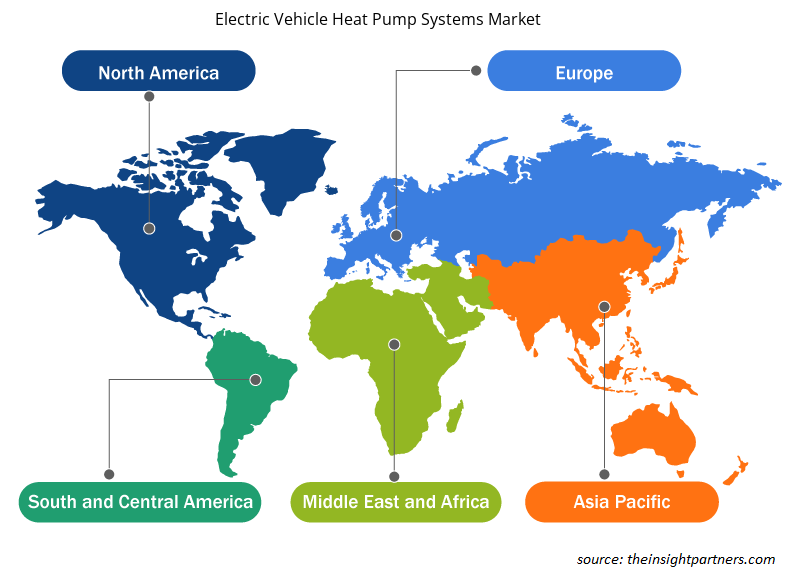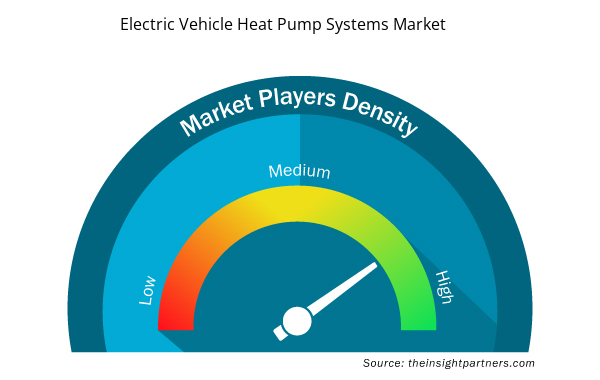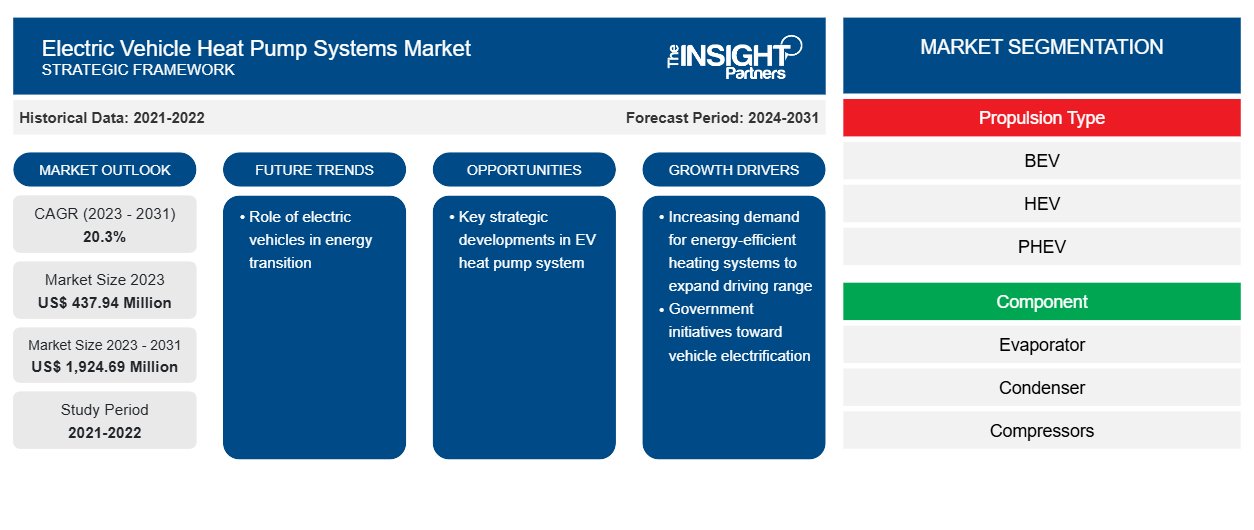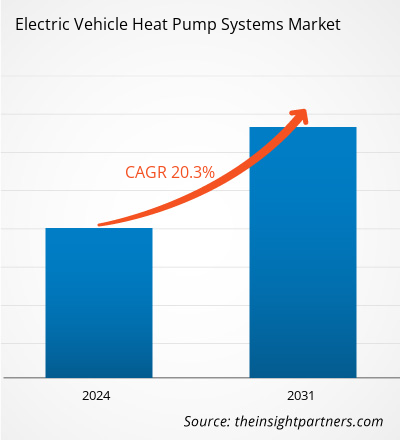电动汽车热泵系统市场规模预计将从 2023 年的 4.3794 亿美元增至 2031 年的 19.2469 亿美元。预计 2023-2031 年期间市场复合年增长率将达到 20.3%。电动汽车在能源转型中的作用日益增强,很可能仍是未来市场的一个关键趋势。
电动汽车热泵系统市场分析
乘用车领域电动汽车销量的增加是全球电动汽车热泵系统市场的主要驱动因素之一。2023 年,全球新电动汽车注册量达到 1400 万辆,占道路上电动汽车总数的约 4000 万辆。2023 年电动汽车销量比 2022 年高出约 350 万辆,同比增长约 35%。用于物流和运输的电动商用车的日益普及也对全球电动汽车热泵系统的需求产生了积极影响。此外,混合动力电动汽车在公用事业规模应用中的使用率不断提高,预计将在预测期内为电动汽车热泵系统市场创造重大机遇。
电动汽车热泵系统市场概览
电动汽车 (EV) 销量的不断增长以及交通运输领域对可持续环保选择的需求不断增长推动了电动汽车热泵系统市场的发展。此外,电动汽车加热和冷却设施方面的技术进步不断提高,推动了电动汽车热泵的全球应用。电动汽车市场销量的增长,特别是乘用电动汽车需求的增长,正在推动热泵的采购,预计这将推动全球电动汽车热泵系统市场的增长。
北美、欧洲和亚太地区是电动汽车热泵系统市场的主要地区,其次是中东和非洲以及南美和中美洲。中国、美国、法国和英国是电动汽车热泵系统市场增长的主要贡献国家。由于更多车型的推出、车队承诺的增加以及政府的环境政策,轻型商用电动汽车的销量将迅速增长。到 2040 年,轻型商用电动汽车的销量预计将达到全球销量的 70% 左右,其中中国将占据主导地位。预计到 2030 年,全球电动汽车销售总额将达到 8.8 万亿美元,到 2050 年将达到 57 万亿美元。乘用车和商用车领域对电动汽车的需求不断增长,成为全球电动汽车热泵系统市场的主要推动力。
定制此报告以满足您的需求
您可以免费定制任何报告,包括本报告的部分内容、国家级分析、Excel 数据包,以及为初创企业和大学提供优惠和折扣
- 获取此报告的关键市场趋势。这个免费样品将包括数据分析,从市场趋势到估计和预测。
电动汽车热泵系统市场驱动因素和机遇
为延长行驶里程,对节能加热系统的需求不断增加
流行的电动汽车 (EV) 大多使用锂离子电池为其电动机供电。这些类型的电池的理想工作温度范围似乎在 50°F 到 110°F 之间,一些出版商一致认为最佳温度范围是 70°F。在零下温度下,锂离子电池无法适当储存能量,导致性能不佳。在寒冷天气下,一些电动汽车的续航里程从可控的 10% 下降到约 36%。续航里程的损失不仅仅是由于锂离子电池,还取决于储存能量的利用率。此外,从电池中提取的能量用于加热电阻器,然后吹过电阻器以保持车内温暖,这会导致电池老化。因此,热泵在为电池提供热量方面很重要。与仅仅从电池中获取能量相比,热泵更有效地加热汽车内部。热泵系统本身并不是续航里程扩展器,而是一种工具,可使电动汽车更高效,并且在零下温度下不会损失太多续航里程。
电动汽车热泵系统的关键战略发展
热泵系统在电动汽车中的应用越来越广泛,这归功于其相关优势,包括高性能、高效率、电池续航里程长、充电时间短等。热泵系统应用的增加为电动汽车热泵系统市场的主要公司扩大其产品供应和全球影响力铺平了道路。随着热泵成为电动汽车的重要组成部分,它们在暖通空调行业中的作用将越来越大,为提高电动汽车的行驶里程创造了机会。电动汽车的暖通空调业务价值链与汽车行业、热管理组件和制冷剂等密切相关。此外,通过合作伙伴关系、协作和合资企业开发有效热管理系统的研发计划的增加预计将为预测期内在电动汽车热泵系统市场运营的主要公司创造机会。以下是电动汽车热泵系统市场的一些关键战略举措或发展:
- 2023年5月,韩国热管理系统供应商Hanon Systems Corp.宣布,计划投资4000万美元在美国佐治亚州建立热泵系统工厂,预计该工厂将于2024年投入生产。
- 2023 年 6 月,德国国防公司和汽车供应商莱茵金属公司推出或推出了一款用于即插即用电动汽车的新型模块化热泵系统。通过此次产品开发,莱茵金属公司加强了其在电动汽车行业的热泵系统产品供应。
- 2022 年 4 月,通用汽车推出了在其 Ultium 电动汽车平台上增加热泵系统的计划。该 Ultium 平台是 GMC Hummer EV 和 Chevy Silverado EV 等车型的主要电动汽车架构。这将加强该公司在市场上的地位。
- 2023 年 10 月,莱茵金属赢得了欧洲一家电动拖拉机制造商的创新即插即用热泵解决方案订单。这份新合同预计将持续七年,第一台热泵预计将于 2024 年交付用于现场试验。
- 2023年3月,三菱重工热系统株式会社开发出专为电动汽车设计的新型电动运输制冷机组TEJ35AM,该机组配备热泵加热功能,可使用电动汽车电源运行,高效运行,减少碳排放。
- 2023 年 7 月,采埃孚股份公司推出了一款新概念乘用电动汽车,该车配备了用于电动驱动电机和乘客舱的热管理系统。它包括一个基于 800V 丙烷 (R290) 的热泵。
预计电动汽车热泵系统市场中的这些关键战略发展将为预测期内在市场上运营的主要参与者创造机会。
电动汽车热泵系统市场报告细分分析
- 根据推进类型,电动汽车热泵系统市场分为 BEV、HEV 和 PHEV。BEV 细分市场在 2023 年占据了最大的市场份额。
- 就组件而言,市场分为蒸发器、冷凝器、压缩机等。压缩机部分在 2023 年占据了最大的市场份额。
- 根据车型,市场分为乘用车和商用车。商用车领域在 2023 年占据了更大的市场份额。
电动汽车热泵系统市场份额(按地区)分析
电动汽车热泵系统市场报告的地理范围主要分为五个区域:北美、亚太、欧洲、中东和非洲、南美和中美。
全球电动汽车热泵系统市场分为北美、欧洲、亚太地区、中东和非洲以及南美。2023 年,欧洲占据了电动汽车热泵系统最大的市场份额,预计在预测期内仍将保持主导地位。这归因于多种因素,例如对电动汽车 (EV) 的需求增加;政府对电动汽车可持续、节能和智能热管理产品的举措;以及人们对提高能源效率和延长电动汽车续航里程的认识不断提高。2023 年,北美占据电动汽车热泵系统市场的第二大份额,为 33.7%,预计 2023 年至 2031 年的复合年增长率为 19.4%。这是由于人们对电动汽车的能源效率和电池续航里程延长的认识不断提高。此外,政府为减少碳排放而推广电动汽车的举措预计将在预测期内推动对电动汽车热泵系统的需求。
由于电动汽车销量增长,亚太地区、中东和非洲以及南美和中美洲也为全球电动汽车热泵系统市场的增长做出了贡献。此外,政府为满足各地区减少碳排放的需求而加大对汽车电气化的融资或补贴力度,这也推动了市场的增长。此外,预计亚太地区和中东经济体(如印度、印度尼西亚、泰国、新加坡、沙特阿拉伯、阿联酋等)电动汽车行业的增长将在 2023 年至 2031 年间推动对电动汽车热泵系统的需求。
电动汽车热泵系统市场区域洞察
Insight Partners 的分析师已详尽解释了预测期内影响电动汽车热泵系统市场的区域趋势和因素。本节还讨论了北美、欧洲、亚太地区、中东和非洲以及南美和中美洲的电动汽车热泵系统市场细分和地理位置。

- 获取电动汽车热泵系统市场的区域特定数据
电动汽车热泵系统市场报告范围
| 报告属性 | 细节 |
|---|---|
| 2023 年的市场规模 | 4.3794亿美元 |
| 2031 年市场规模 | 19.2469亿美元 |
| 全球复合年增长率(2023 - 2031) | 20.3% |
| 史料 | 2021-2022 |
| 预测期 | 2024-2031 |
| 涵盖的领域 | 按推进类型
|
| 覆盖地区和国家 | 北美
|
| 市场领导者和主要公司简介 |
|
市场参与者密度:了解其对商业动态的影响
电动汽车热泵系统市场正在快速增长,这得益于终端用户需求的不断增长,而这些需求又源于消费者偏好的不断变化、技术进步以及对产品优势的认识不断提高等因素。随着需求的增加,企业正在扩大其产品范围,进行创新以满足消费者的需求,并利用新兴趋势,从而进一步推动市场增长。
市场参与者密度是指在特定市场或行业内运营的企业或公司的分布情况。它表明在给定市场空间中,相对于其规模或总市场价值,有多少竞争对手(市场参与者)存在。
在电动汽车热泵系统市场运营的主要公司有:
- 电装公司
- Titanx 发动机冷却
- 摩丁制造公司
- 三电公司
- 翰农系统
- 马勒有限公司
免责声明:上面列出的公司没有按照任何特定顺序排列。

- 了解电动汽车热泵系统市场顶级关键参与者概况
电动汽车热泵系统市场新闻和最新发展
电动汽车热泵系统市场通过收集一手和二手研究后的定性和定量数据进行评估,其中包括重要的公司出版物、协会数据和数据库。电动汽车热泵系统市场的一些发展情况如下:
Hanon Systems 是一家全球领先的电动汽车热管理供应商,该公司重申了其致力于通过创新的电动汽车 (EV) 解决方案(例如其行业领先的热泵系统和组件)打造清洁能源未来的承诺。电动汽车续航里程仍然是消费者和汽车制造商共同关注的问题,尤其是在冬季条件下。加热座舱以让乘客感到舒适并在寒冷条件下保持电池和电力电子设备的最佳温度所需的电池能量对公司构成了巨大挑战。(来源:Hanon Systems,新闻稿,2024 年 2 月)
电动汽车热泵系统市场报告范围和交付成果
“电动汽车热泵系统市场规模和预测(2021-2031 年)”报告对以下领域进行了详细的市场分析:
- 电动汽车热泵系统市场规模及全球、区域和国家层面所有主要细分市场的预测
- 电动汽车热泵系统市场趋势,以及驱动因素、限制因素和关键机遇等市场动态
- 详细的 PEST 和 SWOT 分析
- 电动汽车热泵系统市场分析,涵盖主要市场趋势、全球和区域框架、主要参与者、法规和最新市场发展
- 行业格局和竞争分析,涵盖市场集中度、热图分析、知名参与者以及电动汽车热泵系统市场的最新发展
- 详细的公司简介
- 历史分析(2 年)、基准年、预测(7 年)及复合年增长率
- PEST 和 SWOT 分析
- 市场规模价值/数量 - 全球、区域、国家
- 行业和竞争格局
- Excel 数据集



Report Coverage
Revenue forecast, Company Analysis, Industry landscape, Growth factors, and Trends

Segment Covered
This text is related
to segments covered.

Regional Scope
North America, Europe, Asia Pacific, Middle East & Africa, South & Central America

Country Scope
This text is related
to country scope.
常见问题
Key strategic developments in EV heat pump system is one of the major factors likely to generate new opportunities for market vendors in the coming years.
Europe dominated the global electric vehicle heat pump systems market in 2023 and is likely to retain its dominance during the forecast period as well.
Role of electric vehicles in energy transition is one of the major trends in the aircraft bracket market.
Increasing demand for energy-efficient heating systems to expand driving range; government initiatives toward vehicle electrification are some of the major factors driving the market growth.
Denso Corporation, Titanx Engine Cooling, Modine Manufacturing Company, Sanden Corporation, Hanon Systems, MAHLE GmbH, Valeo, Highly Marelli Holdings Co Ltd, Mitsubishi Heavy Industries Ltd, Rheinmetall AG, and MAN Energy Solutions are the key market players operating in the global electric vehicle heat pump systems market.
Trends and growth analysis reports related to Automotive and Transportation : READ MORE..
The List of Companies - Electric Vehicle Heat Pump Systems Market
- Denso Corporation
- Titanx Engine Cooling
- Modine Manufacturing Company
- Sanden Corporation
- Hanon Systems
- MAHLE GmbH
- Valeo
- Highly Marelli Holdings Co Ltd
- Mitsubishi Heavy Industries Ltd
- Rheinmetall AG
- MAN Energy Solutions
The Insight Partners performs research in 4 major stages: Data Collection & Secondary Research, Primary Research, Data Analysis and Data Triangulation & Final Review.
- Data Collection and Secondary Research:
As a market research and consulting firm operating from a decade, we have published and advised several client across the globe. First step for any study will start with an assessment of currently available data and insights from existing reports. Further, historical and current market information is collected from Investor Presentations, Annual Reports, SEC Filings, etc., and other information related to company’s performance and market positioning are gathered from Paid Databases (Factiva, Hoovers, and Reuters) and various other publications available in public domain.
Several associations trade associates, technical forums, institutes, societies and organization are accessed to gain technical as well as market related insights through their publications such as research papers, blogs and press releases related to the studies are referred to get cues about the market. Further, white papers, journals, magazines, and other news articles published in last 3 years are scrutinized and analyzed to understand the current market trends.
- Primary Research:
The primarily interview analysis comprise of data obtained from industry participants interview and answers to survey questions gathered by in-house primary team.
For primary research, interviews are conducted with industry experts/CEOs/Marketing Managers/VPs/Subject Matter Experts from both demand and supply side to get a 360-degree view of the market. The primary team conducts several interviews based on the complexity of the markets to understand the various market trends and dynamics which makes research more credible and precise.
A typical research interview fulfils the following functions:
- Provides first-hand information on the market size, market trends, growth trends, competitive landscape, and outlook
- Validates and strengthens in-house secondary research findings
- Develops the analysis team’s expertise and market understanding
Primary research involves email interactions and telephone interviews for each market, category, segment, and sub-segment across geographies. The participants who typically take part in such a process include, but are not limited to:
- Industry participants: VPs, business development managers, market intelligence managers and national sales managers
- Outside experts: Valuation experts, research analysts and key opinion leaders specializing in the electronics and semiconductor industry.
Below is the breakup of our primary respondents by company, designation, and region:

Once we receive the confirmation from primary research sources or primary respondents, we finalize the base year market estimation and forecast the data as per the macroeconomic and microeconomic factors assessed during data collection.
- Data Analysis:
Once data is validated through both secondary as well as primary respondents, we finalize the market estimations by hypothesis formulation and factor analysis at regional and country level.
- Macro-Economic Factor Analysis:
We analyse macroeconomic indicators such the gross domestic product (GDP), increase in the demand for goods and services across industries, technological advancement, regional economic growth, governmental policies, the influence of COVID-19, PEST analysis, and other aspects. This analysis aids in setting benchmarks for various nations/regions and approximating market splits. Additionally, the general trend of the aforementioned components aid in determining the market's development possibilities.
- Country Level Data:
Various factors that are especially aligned to the country are taken into account to determine the market size for a certain area and country, including the presence of vendors, such as headquarters and offices, the country's GDP, demand patterns, and industry growth. To comprehend the market dynamics for the nation, a number of growth variables, inhibitors, application areas, and current market trends are researched. The aforementioned elements aid in determining the country's overall market's growth potential.
- Company Profile:
The “Table of Contents” is formulated by listing and analyzing more than 25 - 30 companies operating in the market ecosystem across geographies. However, we profile only 10 companies as a standard practice in our syndicate reports. These 10 companies comprise leading, emerging, and regional players. Nonetheless, our analysis is not restricted to the 10 listed companies, we also analyze other companies present in the market to develop a holistic view and understand the prevailing trends. The “Company Profiles” section in the report covers key facts, business description, products & services, financial information, SWOT analysis, and key developments. The financial information presented is extracted from the annual reports and official documents of the publicly listed companies. Upon collecting the information for the sections of respective companies, we verify them via various primary sources and then compile the data in respective company profiles. The company level information helps us in deriving the base number as well as in forecasting the market size.
- Developing Base Number:
Aggregation of sales statistics (2020-2022) and macro-economic factor, and other secondary and primary research insights are utilized to arrive at base number and related market shares for 2022. The data gaps are identified in this step and relevant market data is analyzed, collected from paid primary interviews or databases. On finalizing the base year market size, forecasts are developed on the basis of macro-economic, industry and market growth factors and company level analysis.
- Data Triangulation and Final Review:
The market findings and base year market size calculations are validated from supply as well as demand side. Demand side validations are based on macro-economic factor analysis and benchmarks for respective regions and countries. In case of supply side validations, revenues of major companies are estimated (in case not available) based on industry benchmark, approximate number of employees, product portfolio, and primary interviews revenues are gathered. Further revenue from target product/service segment is assessed to avoid overshooting of market statistics. In case of heavy deviations between supply and demand side values, all thes steps are repeated to achieve synchronization.
We follow an iterative model, wherein we share our research findings with Subject Matter Experts (SME’s) and Key Opinion Leaders (KOLs) until consensus view of the market is not formulated – this model negates any drastic deviation in the opinions of experts. Only validated and universally acceptable research findings are quoted in our reports.
We have important check points that we use to validate our research findings – which we call – data triangulation, where we validate the information, we generate from secondary sources with primary interviews and then we re-validate with our internal data bases and Subject matter experts. This comprehensive model enables us to deliver high quality, reliable data in shortest possible time.


 获取此报告的免费样本
获取此报告的免费样本